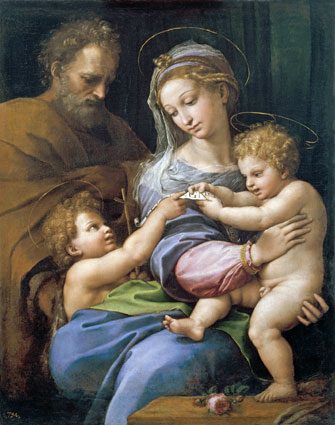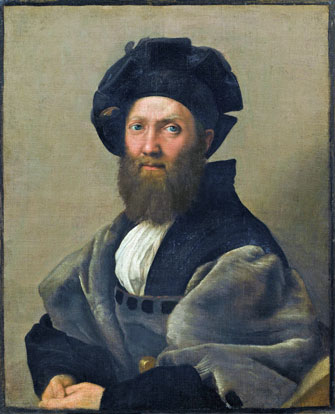Who’s Who in
Raphael’s Sphere

”The Madonna of the Rose” (c. 1516), attributed to Raphael. Read a thorough analysis of this painting here. © Museo nacional del Prado, Madrid
In his short 20-year career, Raphael (1483-1520) managed to produce a brilliant and impressively large collection of works, but he didn’t do it alone. His popularity in his lifetime was so great and the number of his prestigious commissions so extensive that, – especially in the later years, he had to rely on his understudies, so to speak – his workshop assistants, around 50 of them – to produce much of the work. Those are the years (1513-20) covered by the exhibition “Late Raphael” at the Louvre.
Only 24 paintings in the show, which includes around a hundred, along with drawings and tapestries, are clearly identified as being by Raphael alone. The rest are attributed to “Raphael and workshop” or to other artists, mostly his two leading acolytes, Giulio Romano (1499-1546) and Gianfrancesco Penni (c. 1496-1528), both of whom had successful careers after the death of Raphael. As you get to know the individual styles of the three painters, it becomes something of a game to try to figure out who painted each work before you read the label.
First, however, the exhibition steeps you in the work of the master himself and explains how in his work he combined elements of the styles of two of his great Renaissance rivals, his contemporaries Leonardo and Michelangelo: the sweet facial expressions painted by the former and the expressive power and Antique-style nobility of the work of the latter. The curators also explain that although Raphael is often considered the epitome of Renaissance Classicism, his work was in reality too diverse to be so narrowly labeled. This is clear in “La Belle Jardinière” (1507-08), for example, a work painted in Florence, in which St. Anne’s gentle expression and billowing dress are inspired by Leonardo and the pose of Jesus by Michelangelo’s “Madonna of Bruges ” (1501-04).
After he moved in 1508 to Rome, where he had been put in charge of the decoration of the apartment of Pope Julius II’s apartment in the Vatican, Raphael continued to take inspiration from the two artists, imitating the terribilità (awe-inspiring power) of Michelangelo’s Sistine Chapel ceiling and Leonardo’s sfumato (gradations from light to dark, with no clear outlines) and somber tone.
One room is full of works by (or mostly by) the master himself, among them the action-packed large-format painting “Christ Falling on the Way to Calvary, or Lo Spasimo di Sicilia” (1515-16) (look closely and you see will right in the middle of the painting’s swirl of activity a leg that doesn’t seem to belong to any visible body); the magnificent “Saint Michael Vanquishing Satan” (1518) (compare Penni’s modello with the finished painting corrected by Raphael to see how much more dynamic the latter is); and “The Ecstasy of St. Cecilia” (1515-16), one of the few late Raphaels to have been painted almost entirely by his hand, which personifies the three Neoplatonist states of music: Saint Cecila, surrounded by four fellow saints, stops playing her organ (representing human music) to listen to the heavenly music being played by the angels seen through a parting in the clouds above her head, while broken instruments strewn on the ground at her feet represent the imperfection of earthly music.
Most of the rest of the exhibition is devoted to workshop paintings, and Romano and Penni even have their own mini-shows within the show of works painted after the death of Raphael (elsewhere in the building, there is a show of Romano’s drawings and of the works of Luca Penni, Gianfrancesco Penni’s brother). While both were undeniably talented, they didn’t quite measure up to the master. At the end of the show, after a long detour via their

Raphael’s “Portrait de Baldassare Castiglione” (1519). © RMN (Musée du Louvre)/Tony Querrec
works and studies for other pieces, we come back to Raphael, with a room full of portraits, most notably the beautiful “La Donna Velata” (1512-18) and the masterpiece of sensitive portraiture that is “Baldassare Castiglione” (1514-15), both of which belong to the Louvre.
Musée du Louvre: Hall Napoléon. Métro: Palais-Royal-Musée du Louvre. Open Wednesday-Monday, 9am-5.45pm (until 9.45pm on Wednesday and Friday). Closed Tuesday. Admission: €12. Through January 14, 2013. www.louvre.fr
Reader reaction: Click here to respond to this article (your response may be published on this page and is subject to editing).
Please support Paris Update by ordering books from Paris Update’s Amazon store at no extra cost. Click on your preferred Amazon location: U.K., France, U.S.
More reviews of Paris art shows.
© 2012 Paris Update
